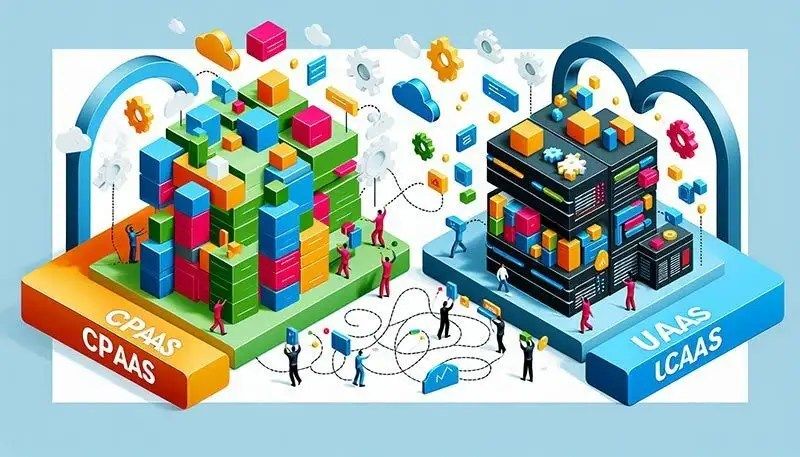Beyond ChatGPT: What Does it Take to Create Real CX AI?
- 1. Introduction
- 2. Key Takeaways
- 3. Understanding CPaaS: The Backbone of Modern Communication
- 4. The Mechanics Behind CPaaS: How It Powers Communication
- 5. The Strategic Advantage of CPaaS for Businesses
- 6. Tailoring Customer Interactions
- 7. Transforming Internal Workflow
- 8. The CPaaS Market Landscape: Trends and Growth
- 9. CPaaS Versus UCaaS: Choosing the Right Platform
- 10. Key Features of Top CPaaS Solutions
- 11. Enhancing Real-Time Interaction
- 12. Empowering with AI and Automation
- 13. Practical Use Cases: CPaaS in Action
- 14. Streamlining Healthcare Communication
- 15. Revolutionizing Retail Customer Service
- 16. Securing Your Communications with CPaaS
- 17. Integrating CPaaS into Your Business
- 18. CPaaS Pricing Models: Understanding Costs
- 19. CPaaS is the Future of Business Communication
- 20. Summary
- 21. Call to Action
- 22. Frequently Asked Questions
Key Takeaways
- CPaaS is a cloud-based platform that enables seamless real-time communication by integrating various communications features like voice, video calls, live chat, and emails into business applications, aimed particularly at companies adopting a cloud-first approach.
- CPaaS offers strategic business advantages such as operational efficiency, customized customer interactions and enhanced internal workflow, it’s becoming a key resource in digital transformation and customer experience improvement.
- The CPaaS market is experiencing significant growth, expected to reach $29.7 billion by 2026, with trends focusing on messaging services, video conferencing, data analytics, and compliance with data protection regulation.
Understanding CPaaS: The Backbone of Modern Communication

The Mechanics Behind CPaaS: How It Powers Communication
The Strategic Advantage of CPaaS for Businesses

Tailoring Customer Interactions
The pulse of any business lies in its ability to connect with customers, and CPaaS excels in crafting these connections through its diverse communications features. By integrating a mosaic of communication channels, from social media messaging to interactive voice response systems, CPaaS ensures that each customer touchpoint is both personalized and consistent, regardless of the chosen medium. This omnichannel approach is not a mere feature; it’s a strategic imperative that aligns with the evolving preferences of customers, enabling businesses to deliver a truly unified experience.Retailers, for example, harness the power of CPaaS to:Transforming Internal Workflow
Beyond customer interactions, CPaaS transforms the inner workings of business operations. The integration of unified communications within an organization’s existing systems unifies diverse channels, enhancing collaboration and optimizing the tracing of interactions. This unity is not just about connection but about creating a tapestry of workflows that are streamlined for maximum efficiency, minimizing human intervention, and maximizing productivity.As businesses navigate the digital transformation journey, CPaaS acts as a catalyst, seamlessly blending communications features such as directories and chat rooms into existing applications. This integration is a game-changer, smoothing the transition from traditional systems to more fluid and responsive workflows that are the hallmarks of modern business operations.The CPaaS Market Landscape: Trends and Growth

CPaaS Versus UCaaS: Choosing the Right Platform

Key Features of Top CPaaS Solutions
Top-tier CPaaS solutions are distinguished by their robust APIs and SDKs, acting as the foundational elements for a host of real-time communications features. These cpaas solution providers are the craftsmen of integration, cutting down development time from months to mere days and offering the flexibility of both coding from scratch and utilizing low-code/no-code options.With capabilities ranging from voice and instant messaging to the integration of various channels like SMS and MMS, top CPaaS solutions empower businesses with both seamless integration and enhanced communications capabilities.Enhancing Real-Time Interaction
In the domain of real-time interaction, CPaaS platforms are truly groundbreaking with their advanced communications features. WebRTC technology has emerged as a pivotal enabler, allowing for browser-based audio and video calls that require no additional downloads, and facilitating both one-on-one and group conferences. The modular approach that CPaaS providers offer is comparable to constructing with a set of Lego blocks, granting developers the freedom to assemble various communication features to craft uniquely tailored experiences.The versatility doesn’t end there; customizable VoIP capabilities are integral to CPaaS, enabling businesses to:Empowering with AI and Automation
The integration of AI and automation in CPaaS platforms signifies a step towards more intelligent, efficient communications features. Visual editors on CPaaS platforms democratize the creation of sophisticated interactive voice response systems, making them accessible to users without deep technical expertise.For instance, Vonage’s AI Studio is a testament to this empowerment, simplifying the creation of AI-powered virtual assistants that can transform self-service systems into intelligent, responsive entities capable of handling complex interactions.Practical Use Cases: CPaaS in Action
The versatility of CPaaS shines best in its practical use cases across a range of industries, thanks to its advanced communications features. Here are some examples:Streamlining Healthcare Communication
CPaaS has revolutionized healthcare, simplifying communications between providers and patients through its advanced communications features. It facilitates crucial services such as appointment confirmations, reminders, and patient follow-ups, ensuring that the healthcare journey is seamless for both patients and providers.This continuous patient care model, empowered by CPaaS, not only enhances the quality of care but also elevates the patient experience, making healthcare more accessible and responsive.Revolutionizing Retail Customer Service
CPaaS greatly influences retail customer service with its advanced communications features. By unifying communication channels, CPaaS ensures a consistent and personalized customer experience across various platforms, from in-store interactions to online customer service. Personalized strategies, such as targeted messaging and promotional offers, are now at retail businesses’ fingertips, thanks to CPaaS.This technology also propels technical support capabilities forward by integrating chatbots and automated tools that facilitate self-service, while allowing for seamless escalation to human assistance when needed.Securing Your Communications with CPaaS
In a time when data security is of utmost importance, CPaaS emerges as a beacon of trust with its built-in security and advanced communications features. Built-in security features are a hallmark of cloud-based CPaaS platforms, designed to protect sensitive data and enhance a business’s security posture on a cloud based platform. Verification APIs, multi-factor authentication, and strong encryption algorithms are just a few of the robust measures CPaaS employs to safeguard communications against unauthorized access.Moreover, CPaaS providers offer the following security measures:Integrating CPaaS into Your Business
Incorporating CPaaS into a business’s communication infrastructure necessitates a combination of technical skills and strategic vision to leverage its advanced communications features. Key steps in this process include:CPaaS Pricing Models: Understanding Costs
For businesses contemplating its adoption, grasping the financial implications of CPaaS and its advanced communications features is essential. CPaaS vendors typically offer two main pricing models: pay-as-you-go or monthly subscription fees, providing businesses with options that align with their usage patterns and budgetary constraints. The pay-as-you-go model caters to businesses that prefer to be billed based on actual usage, while the subscription model offers a predictable monthly cost, making budgeting more manageable.By leveraging the provider’s communications infrastructure, businesses can enjoy the following benefits:Why CPaaS is the Future of Business Communication
Communications Platform as a Service (CPaaS) is transforming the way businesses manage communication. Here’s why it’s the future:- Simplifying Communication Processes with Unified Platforms: CPaaS consolidates multiple communication channels into a single, easy-to-manage platform, streamlining workflows and improving efficiency.
- Reducing Costs Through Cloud-Based Infrastructure: By utilizing cloud-based communication tools, businesses can eliminate expensive hardware and reduce operational expenses while maintaining high-quality communication.
Key Features of NiCE CPaaS Solutions
NiCE CPaaS solutions offer cutting-edge features designed to enhance business communication and scalability. Key features include:- API Integrations for Custom Workflows: Easily integrate with existing systems using APIs to create tailored communication workflows that align with specific business needs.
- Scalable Solutions for Growing Businesses: NiCE CPaaS solutions are designed to grow alongside your business, offering the flexibility to scale resources and capabilities as your needs evolve.










